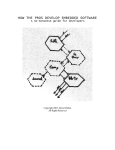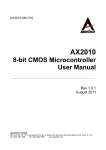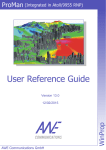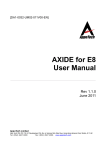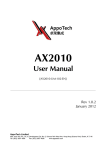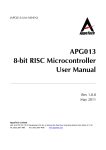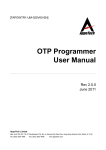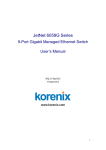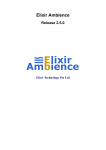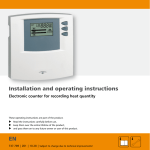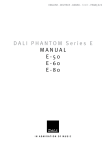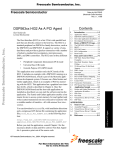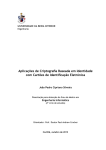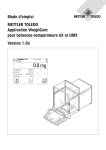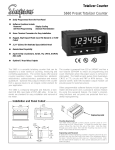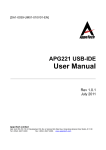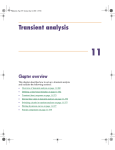Download AX3008 IDE User Manual
Transcript
AX206 DFP Development Handbook v0.0.2 Confidential AppoTech Limited Address : Unit 705-707, 7/F, IC Development Centre, No. 6, Science Park West Ave. Hong Kong Science Park, Shatin, N.T. Hong Kong Tel :(852) 2607 4090 Fax :(852) 2607 4096 www.appotech.com AX206 DFP DEVELOPMENT HANDBOOK V0.0.2 Table of Contents Chapter 1 Introduction ............................................................................. 4 1.1. Objective of this Handbook .................................................................................. 4 1.2. Style and Symbol Conventions ............................................................................ 4 Chapter 2 The Development Process ..................................................... 5 2.1. Program Requirements ........................................................................................ 5 2.2. Compilation and Linking Sectors .......................................................................... 5 2.3. Supporting Tools: Gen and CRC .......................................................................... 6 2.4. Supporting tool: MAKE ......................................................................................... 6 2.4.1. Add a Sector Group ...................................................................................... 6 2.4.2. Makefile Child ............................................................................................... 6 2.5. Interaction between Sectors ................................................................................. 7 2.5.1. Add a Sector ................................................................................................. 7 2.5.2. Standard control between Sectors................................................................ 7 2.5.3. Data sharing between sectors ...................................................................... 9 2.5.4. Other operations between sectors................................................................ 9 2.5.5. Some important files for sectors ................................................................... 9 2.6. Library and Background Process ....................................................................... 10 2.6.1. Library ......................................................................................................... 10 2.6.2. Background Process ................................................................................... 11 2.6.3. Code and Data Security .............................................................................. 11 Chapter 3 3.1. Sector Group and Sector...................................................... 12 _Start .................................................................................................................. 13 3.1.1. Common.asm .............................................................................................. 13 3.1.2. System Initialization .................................................................................... 14 3.2. Analog................................................................................................................. 14 2 Copyright @ 2009 AppoTech Ltd Development Handbook Address: Unit 705-707, 7/F, IC Development Centre, No.6, Science Park West Ave., Hong Kong Science Park, Shatin, N.T., HK Tel: (852) 2607 4090 Fax: (852) 2607 4096 www.appotech.com AX206 DFP DEVELOPMENT HANDBOOK V0.0.2 3.3. CommonEvent .................................................................................................... 14 3.4. DigClock ............................................................................................................. 15 3.5. JudgeMenu ......................................................................................................... 15 3.6. LCD ..................................................................................................................... 15 3.7. PhotoDis ............................................................................................................. 16 3.8. PicDecod ............................................................................................................ 16 3.9. TimeZone ............................................................................................................ 17 3.10. LibProc (Menu) ............................................................................................... 17 3.11. System Configuration - Config.ini ................................................................... 19 3.11.1. Screen setting ............................................................................................. 19 3.11.2. Clock version selection ............................................................................... 19 3.11.3. Temperature function setting ...................................................................... 19 3.11.4. Time Zone setting ....................................................................................... 19 3.12. Menu Configuration – Menu_Config.ini .......................................................... 20 3.13. Adding Sector ................................................................................................. 21 3.14. Resources ....................................................................................................... 21 3.15. Add-on Sectors ............................................................................................... 22 3.16. Planning and Distribution of RAM .................................................................. 22 Chapter 4 IDE Usage Guide ................................................................... 24 Chapter 5 Common Functions Customization ..................................... 25 5.1. LCD Display Resolution ..................................................................................... 25 5.2. Background and Foreground Color in DPF........................................................ 25 5.3. Add in Digital Resources .................................................................................... 26 5.4. Compression rate and Max Photos limit ............................................................ 26 Appendix I Revision History ..................................................................... 27 3 Copyright @ 2009 AppoTech Ltd Development Handbook Address: Unit 705-707, 7/F, IC Development Centre, No.6, Science Park West Ave., Hong Kong Science Park, Shatin, N.T., HK Tel: (852) 2607 4090 Fax: (852) 2607 4096 www.appotech.com AX206 DFP DEVELOPMENT HANDBOOK V0.0.2 Chapter 1 Introduction 1.1.Objective of this Handbook This handbook describes the development process of AX206. 1.2.Style and Symbol Conventions Throughout this document, certain style, format and font conventions are used to signal particular distinctions for the affected text. Table 1-1 lists the symbols, terms and typographic conventions used in this manual. Table 1-1: Document Conventions Font Convention Convention Description Arial Font The standard font used for all text, figures and tables within this manual. Other fonts, as described below, are used to set off mathematical and logical expressions, or device instruction code, from descriptive text. Courier New Font Within text, this font is used for contrast with the standard text font and specifically denote the following: 1. an instruction set mnemonic or assembler code fragment. 2. the binary value of a bit, range of bits, or a register. 3. the logical state of a digital signal. Within code examples, this font is used exclusively to denote an assembly or high-level language instruction sequence. 4 Copyright @ 2009 AppoTech Ltd Development Handbook Address: Unit 705-707, 7/F, IC Development Centre, No.6, Science Park West Ave., Hong Kong Science Park, Shatin, N.T., HK Tel: (852) 2607 4090 Fax: (852) 2607 4096 www.appotech.com AX206 DFP DEVELOPMENT HANDBOOK V0.0.2 Chapter 2 The Development Process 2.1.Pre-development Preparations The AX206 Development Kit includes a development board (firmware included), buzzer and power supply. To start development, user should separately purchase the compiler tools, Keil C51 Development Tools and UEStudio. 2.2.Program Requirements AX206 has 3KB memory. There is not enough RAM to load a large scale project. When developing AX206, it is necessary to break down the code into sectors. In any time, there should be less than 3KB program in the RAM. In Keil, this smaller program is called „Bank‟. The Bank system cannot satisfy our development needs. So in our development process we have not used the „Bank‟ system. To prevent confusion, we refer to our process as sector. Each Sector has its own compilation and linking process. In view of Keil, the Sectors have no connection among them. The connections are established by tools other than Keil. It is possible that a module in a large project cannot fit into a sector. A number of sectors are needed to run a function. To ease management, the sectors working for a module can be put into the same folder. This will form a group of sectors working for a module. 2.3.Compilation and Linking Sectors Keil cannot handle the cross reference between sectors. In the source code, cross reference should be declared using EXTRN. When using Keil compiler to compile and link for the first time, Keil will show a warning but it can still output correct result. The cross-reference value will be 0. This warning can be masked using the linker command DW(1,2). Using Keil to link the first time can output correct size and code table for cross-reference of each sector. With this information, it can build a cross-reference code table. In the table all variables are defined by EQU and declared PUBLIC. The file is in the compilation source file and compiled independently. Afterwards, each sector is linked together with the cross-reference code table, correct result can be produced. 5 Copyright @ 2009 AppoTech Ltd Development Handbook Address: Unit 705-707, 7/F, IC Development Centre, No.6, Science Park West Ave., Hong Kong Science Park, Shatin, N.T., HK Tel: (852) 2607 4090 Fax: (852) 2607 4096 www.appotech.com AX206 DFP DEVELOPMENT HANDBOOK V0.0.2 2.4.Supporting Tools: Gen and CRC The code table for cross reference should be generated by supporting tools. The code table includes function definitions in sectors, address of sector and other resources in Flash. The M51 file generated by Keil linker has the code table for all PUBLIC variables and its values. Following the naming convention, one can easily find the correct name in M51 file and output to the code table. After the first linking, the size of codes is fixed. The start address and size of each resource can be directly output to code table. After the second linking, all codes and resource values are fixed. Gen can take the final position and generate the Flash file. The Hex file generated by Gen will be translated to bin. This still cannot be burned directly to Flash. There are two missing CRC values. It‟s possible to fill in the two CRC by Gen. But it leads to a more complicated Gen process. So we use the CRC tool to generate the values. CRC can first read header, and calculates the first CRC from the program address and size. Then it calculates the CRC of the header. After filling the two CRC in the bin, it can be burned to flash. 2.5.Supporting tool: MAKE Keil cannot support the above complexity in compiling the code, MAKE is the better tool. The master Makefile handles the above control flow. The child Makefile handles the compiling of sector groups and the linking henceforth. (In versions after 20090401, all child Makefiles are put into the master Makefile.) To add a sector, add the record in child Makefiile. To add a sector group, add directory and content in the master Makefile. 2.5.1. Add a Sector Group 1. Create a sector group directory, edit child Makefile and sector process 2. In master Makefile, add the sector name to PROCESS variable. 2.5.2. Makefile Child The child Makefile should achieve three purposes. 1. Stage 1: Compile all sectors. Use DW(1,2) to connect all sectors. Each sector is converted to HEX format. 6 Copyright @ 2009 AppoTech Ltd Development Handbook Address: Unit 705-707, 7/F, IC Development Centre, No.6, Science Park West Ave., Hong Kong Science Park, Shatin, N.T., HK Tel: (852) 2607 4090 Fax: (852) 2607 4096 www.appotech.com AX206 DFP DEVELOPMENT HANDBOOK V0.0.2 2. Stage 2: Input ..\Res.obj, and link all sectors. Change to the Hex format. 3. Clean: Clean all intermediate files 2.6.Interaction between Sectors Interaction includes transfer between sectors and data sharing. 2.6.1. Add a Sector 1) Write the sector to implement the target actions. Compile and link by the child Makefile. 2) Register the sector in sector table in ProcTbl.asm. 3) Allocate Flash space to the sector in ResPos.ini. 2.6.2. Standard control between Sectors Currently the system supports two types of standard control: one sector can call function in another sector, or one sector can jump to another sector. 1. PPUB – sector entrance To allow a sector to be called, it should be marked with PPUB. Example: PPUB lbl ; lbl is a tag in sector 2. PREF – reference to a sector To reference to another sector, it should be first declared with PREF. Example: PREF lbl ; lbl is a tag in sector 3. PCALL - Call a sector To call a function in a sector, use PCALL but not CALL. Example: 7 Copyright @ 2009 AppoTech Ltd Development Handbook Address: Unit 705-707, 7/F, IC Development Centre, No.6, Science Park West Ave., Hong Kong Science Park, Shatin, N.T., HK Tel: (852) 2607 4090 Fax: (852) 2607 4096 www.appotech.com AX206 DFP DEVELOPMENT HANDBOOK PCALL lbl V0.0.2 ; lbl is a tag in sector 4. PRET – Code return After calling PCALL, use PRET to return. 5. PJMP – Jump to a Sector To jump to a Sector, use PJUMP but not jmp. Example: PJMP lbl ; lbl is a tag in sector It‟s allowed to jump from code A to code B, and then from code B to code C. When work is completed in code C, call PRET to return to code A directly. It is not necessary to call PJMP to code B and then PRET to code A. 6. DirectLoadProc – Direct load process This library requires three variables: 1. R5-R7 – Flash address of Sector 2. DPTR – Start address of xData 3. R3:R4 – End address of xData This library can achieve three purposes: 1. Load a sector, for example, to load the _start sector when loading the common event sector ProcMan. ProcMan is used for jumping between sectors. It cannot load itself. This library is needed to load the common event function. 2. Load a PIC. Functions that are called by various sectors cannot be placed in the same address. The functions may include window opening, calculation functions for flashing screen etc. These functions should be placed in different locations depending on the sectors combination. These functions can be written as a address-irrelevant sector. When it is needed, it can be loaded by DirectLoadPorc and called as local functions. 3. Provide a standard load process. Sector without a lot of free space can utilize space at ProcMan. But before the code exits, it should use DirectLoadProc to place ProcMan in the original position. Then it can use the standard transfer method. Please note that DirectLoadProc function, the function that call 8 Copyright @ 2009 AppoTech Ltd Development Handbook Address: Unit 705-707, 7/F, IC Development Centre, No.6, Science Park West Ave., Hong Kong Science Park, Shatin, N.T., HK Tel: (852) 2607 4090 Fax: (852) 2607 4096 www.appotech.com AX206 DFP DEVELOPMENT HANDBOOK V0.0.2 DirectLoadProc and the neighbour codes cannot be located in the same address, otherwise there will be abnormalities. 2.6.3. Data sharing between sectors Currently only EQU data are shared. EQU variables prefixed by „?PPUB?‟ can be accessed by all sectors. For example, sectors defined in ProcTbl can be prefixed by „?PPUB?‟. Other sectors can call the prefixed Sectors. 2.6.4. Other operations between sectors 1. High Efficiency transfer mode The public area in standard control amounts to 200 words. In other special conditions 200 words is extensive. It is necessary to use high efficiency transfer mode. It is advised to use this mode only when necessary. In variables defined by PPUB, there are several EQU variables. - ?FADD?<lbl> - variable values - ?FNUM?<lbl> - sector name Sector that defines the PPUB variables can call the following variables: - ?PADC?<sector name> - sector start address minus 0x800 is the xData start address. - ?PADE?<sector name> - sector end address, minus 0x800 is the xData end address. - ?PADH?<sector name> - sector Flash address (High two words) - ?PADL?<sector name> - sector Flash address (low two words) Using these variables, sector can operate in Flash and jump to other sectors. 2. Sharing extensions Currently the system only supports EQU data sharing. To support other types of data sharing, modify the Gen tools definition and rules. 2.6.5. Some important files for sectors ProcTbl ProcTbl is a special sector. It records the code information such as addresses and size. 9 Copyright @ 2009 AppoTech Ltd Development Handbook Address: Unit 705-707, 7/F, IC Development Centre, No.6, Science Park West Ave., Hong Kong Science Park, Shatin, N.T., HK Tel: (852) 2607 4090 Fax: (852) 2607 4096 www.appotech.com AX206 DFP DEVELOPMENT HANDBOOK V0.0.2 The information is used when in referencing between sectors. ProcTbl can output the sector number. In ProTbl.asm, under ProcTbl each ProCDEF defines the sector. The order number is the sector number. Programmer does not need to memorize the sector number. Each Sector name adding the prefix „?PNUM? is the segtor number. In each sector, code tagged with PPUB adding the ?FNUM? will be the sector number. ResPos.ini ResPos.ini explains the position of resources in Flash. It includes sector resources. In commands defining resources position, resources with the PROCESS command is considered a sector. However, ResPos.ini only defines the sector as a resource in Flash. A sector defined in ResPos.ini only defines the Flash address, and some markings for PPUB in sector. The sector number has not been defined. It is defined by ProcTbl. ProcTbl can be defined as a special sector that output code, but not as a sector that can be transferred. This sector has all the code information, it can execute the normal transfer mode. If it is required, programmer can utilize this feature. ProcMan ProMan handles the transfer between sectors using the sector number and ProcTbl in Flash. The transfer is in standard format. 2.7.Library and Background Process 2.7.1. Library Some codes should be written as library to be called by other codes. However, the size of these codes are too large, they can be written as sector. If library codes are packed as sector, caller of library code may not have the correct saved content when return from calling the library code. To avoid this situation, some design rules should be enforced. The program code can be swapped and the data should be kept. The rules are listed below: 1. Program code should be placed at lower address and data should be placed at higher address. This rule is applicable to transferring between different sectors. For example, when decoding photos, Sectors that read table and decode can cooperate that way. The library code should be kept minimal so that data will not be corrupted. 2. Data can be kept at xData for retrieval. 10 Copyright @ 2009 AppoTech Ltd Development Handbook Address: Unit 705-707, 7/F, IC Development Centre, No.6, Science Park West Ave., Hong Kong Science Park, Shatin, N.T., HK Tel: (852) 2607 4090 Fax: (852) 2607 4096 www.appotech.com AX206 DFP DEVELOPMENT HANDBOOK V0.0.2 Data for function caller can be separated from data for library code. When data memory is not enough, one can consider placing data into xData, 2.7.2. Background Process Larger background process can also be packed as sector. Same as library sector, one should consider the danger of data corruption. 2.7.3. Code and Data Security Library code and background process require consideration on data and code overlapping. It is required to separate data area and code area. The boundary line between data and code area is suggested to be at code address 0x1580, i.e. around 0xD80 xData address. This boundary is approximate. The following rules are suggested: 1. Library and background code should not exceed code address 0x1580. 2. Data code should not be placed less than 0xD80. 11 Copyright @ 2009 AppoTech Ltd Development Handbook Address: Unit 705-707, 7/F, IC Development Centre, No.6, Science Park West Ave., Hong Kong Science Park, Shatin, N.T., HK Tel: (852) 2607 4090 Fax: (852) 2607 4096 www.appotech.com AX206 DFP DEVELOPMENT HANDBOOK V0.0.2 Chapter 3 Sector Group and Sector DFP module functions are separated into sector groups and sectors. In the project, each sector group is a standalone folder. The folder includes source codes of standalone function. The folders that are sector group are listed below: Folder Function description _Start Initialization and interrupt Analog Analog clock display Calendar Calendar display CommonEvent Common event and response DigClock Digital clock, calendar display and clock setup JudgeMenu Contrast and backlight interface display and menu Lcd LCD initialization, window opening PhotoDis Photo display control PicDecod Photo decode TempDetermine Temperature detection TimeZone Time Zone checking USB USB module UserLib Closed source library files LibProc Menu library Other folders Folder Function description Res Menu photo, DFPMate resources Lib Library files Tool Tools 12 Copyright @ 2009 AppoTech Ltd Development Handbook Address: Unit 705-707, 7/F, IC Development Centre, No.6, Science Park West Ave., Hong Kong Science Park, Shatin, N.T., HK Tel: (852) 2607 4090 Fax: (852) 2607 4096 www.appotech.com AX206 DFP DEVELOPMENT HANDBOOK V0.0.2 3.1._Start 3.1.1. Common.asm The sector is interrupt service for timer0. The timer0 is set to 10ms interrupt. Interrupt internal events include: - keys detection, - .ADC detection and calculation, - volume control - software counter (3 sets). (1) Keys detection can process 8 IOs. The key values generation is listed in the following table: Short-press Long-press P3.0 0x10 0x20 P3.1 0x11 0x21 „Up‟ Key P3.2 0x12 0x22 „Down‟ Key P3.3 0x13 0x23 P3.4 0x14 0x24 P3.5 0x15 0x25 P0.6 0x16 0x26 P0.7 Remarks „Power‟ Key USB detection Note the clear key values after key detection. (2) USB detection USB is detected at P0.7. When USB is inserted, yStableSignal is cleared (=0) and bUSB_Insert_Flag Event0[3] is set. When the USB is removed, bUSB_Desert_Flag Event0[4] is set. (3) Battery detection Battery is detected at P0.3 at the 10-bit ADC. It is detected every 2s. Interrupt will detect automatically 8 times and put the values in variables BatteryQ and 13 Copyright @ 2009 AppoTech Ltd Development Handbook Address: Unit 705-707, 7/F, IC Development Centre, No.6, Science Park West Ave., Hong Kong Science Park, Shatin, N.T., HK Tel: (852) 2607 4090 Fax: (852) 2607 4096 www.appotech.com AX206 DFP DEVELOPMENT HANDBOOK V0.0.2 BatteryQ+1. (4) Temperature detection Temperature is detected at P0.2 in ADC. It is detected every 2s. Interrupt will detect automatically 8 times and put the values in variables TemperatuerQ and TemperatureQ+1. (5) Software counter The software counter in timer0 includes 3 sets of counters. They can be used for auto shutdown, delay in showing pictures, etc. 3.1.2. System Initialization The sector for system initialization is Ini.asm. It includes chip‟s IO initialization, variables initialization, etc. 3.2.Analog This sector handles the analog clock display and processes the events in this display. The main code is in Analog_Main.asm. There are two modes available: normal mode and watch mode. To change configuration, change the following setting in the Config.ini: # define WatchVersion 0 ; - normal mode; 1 – watch mode When it is set to watch mode, program code will switch off backlight after 5s to save power. 3.3.CommonEvent This Sector includes common functions that are required in all status, such as power down, low power control, etc. The functions included are listed below: Function Remarks BattStepCal Detect the battery level 14 Copyright @ 2009 AppoTech Ltd Development Handbook Address: Unit 705-707, 7/F, IC Development Centre, No.6, Science Park West Ave., Hong Kong Science Park, Shatin, N.T., HK Tel: (852) 2607 4090 Fax: (852) 2607 4096 www.appotech.com AX206 DFP DEVELOPMENT HANDBOOK V0.0.2 DisLowPower Display low power and enter into Sleep mode KickAlarmEvent Kick start alarm event PowerOffEvent Shut down LibCommonEvent Detemine common events for SetUpDown library and Judge_Slideshow 3.4.DigClock This sector includes clock setup, calendar display and digital clock display. Function Remarks Display_Dig_Clock Display digital clock Display_Dig_Head Set up and display clock Set_Dig_Clock Dis_Clock_setCal_Time Calculate the current time according to variables 3.5.JudgeMenu Setup automatic display time, change contrast, and change backlight level utilize similar functions. These functions are included in JudgeMenu. Function Remarks Judge_Alarm_Clock Setup alarm clock Judge_BackLight Change backlight level Judge_ShutDown Set shut down time Judge_Slideshow Set slideshow display time interval 3.6.LCD The LCD sector includes functions related to the LCD screen. The functions included are: Function Remarks Backlight_Fun Backlight Control 15 Copyright @ 2009 AppoTech Ltd Development Handbook Address: Unit 705-707, 7/F, IC Development Centre, No.6, Science Park West Ave., Hong Kong Science Park, Shatin, N.T., HK Tel: (852) 2607 4090 Fax: (852) 2607 4096 www.appotech.com AX206 DFP DEVELOPMENT HANDBOOK V0.0.2 Lcd_Contrast Contrast Control LcdInit Initilize LCD OpenWin Open window to write data OpenWin_Read Open window to read data Read80 Read a byte from the screen (8080) LcdComm Setting information such as screen resolution and time Under the LCD folder, there are files for some supported LCD screens. To add support for other screens, please create new folder. If normal LCD driver is used (initialization code will be less), user can modify codes using formats in TM125125_Lcd. If the initialization code for LCD driver is too long, it can be put into a table. An example is available at ST7787_2.4Lcd_Table. To create LCD library, the LCD sector links to the whole project through the LCD library. In config.ini, the line “export LCDDIR-TM128128_Lcd” is used to map to the supported screen. When generating the LCD library, a library file called “LCD.LIB” in the folder after „equal‟ sign. Note: (1) When the file in LCD folder has been updated, remember to delete the old List, Obj files already in the folder before creating the LCD library. 3.7.PhotoDis This sector controls the display workflow of photos. The main function is in PhotoDis_Main.asm. 3.8.PicDecod This sector handles photo decode and change photo effect. To change photo using PicDecode fuctions, see the following example: 16 Copyright @ 2009 AppoTech Ltd Development Handbook Address: Unit 705-707, 7/F, IC Development Centre, No.6, Science Park West Ave., Hong Kong Science Park, Shatin, N.T., HK Tel: (852) 2607 4090 Fax: (852) 2607 4096 www.appotech.com AX206 DFP DEVELOPMENT HANDBOOK V0.0.2 mov rd,#4 PCALL PicDecode ;Save the flash address of the photo at R5 R6 R7 (HML) In a DFP project, it is necessary to update part of the photo. For example after the battery logo is displayed, the photo needs to be restored. Using PicDecode can complete the cover function. An example is shown below: mov r4,#1 PCALL PicDecode ; save the photo flash address to R5 R6 R7 (HML) CSEG AT 0x1600 ; table for cover function Cover_Num_Tbl: DB 40 ; There are a total of 40 MCUs need to be covered DB 0,0 ….. DB 11,15 DB 12,15 DB 13,15 DB 14,15 DB 15,15 When the photo is covered, data from Cover_Num_Tbl is used to determine what to cover. For a 128x128 screen, it is divided into a number of 8x8 MCU modules. DB 1,2 represents the first row in the second column MCU module. 3.9.TimeZone This sector includes time zone display and event handling. Descriptions on how to add time zone is included in timeZone.asm. 3.10. LibProc (Menu) This sector controls the menu. The standard version provides menu in high contrast (white 17 Copyright @ 2009 AppoTech Ltd Development Handbook Address: Unit 705-707, 7/F, IC Development Centre, No.6, Science Park West Ave., Hong Kong Science Park, Shatin, N.T., HK Tel: (852) 2607 4090 Fax: (852) 2607 4096 www.appotech.com AX206 DFP DEVELOPMENT HANDBOOK V0.0.2 words on black background). To show menu in other color, update the Menu.asm file. The menu is defined in tables in ActSwtsh.asm. A page of complete menu is shown below: (Menu head info) MENU (Buffer for the current menu) MainMenuADR, 0,0,127,15, MenuItemBuffer (Menu head photo) (Menu head display window position) (Column_start, Row_start, Column_end, Row_end) (Menu display range) MENUCLIENT MainMenuADR, 0,16,128,112 (Menu head photo) (Menu item display position) (Column_start, Row_start, Column_end+1, Row_end+1) (Menu item) MENUITEM USBConnectADR, USBConnectHADR_idx, 0,0,127,15 MENUITEM SlideShowADR, SlideShowHADR_idx, 0,16,127,31 MENUITEM ClockADR, ClockHADR_idx, 0,32,127,47 MENUITEM AutoOffADR, AutoOffADR_idx, 0,48,127,63 MENUITEM BackLightADR, Judge_BackLight_idx, MENUITEM LcdContrastADR,Judge_Lcd_Contrast_idx, 0,80,127,95 MENUITEM DeleteADR, MENUITEM ExitADR,Photo_Disp_After_Menu_Exit_idx, 0,112,127,127 DeleteHADR_idx, (Menu head photo) (Menu item call) 0,64,127,79 0,96,127,111 (Menu item display position) (Column_start, Row_start, Column_end, Row_end) MENUEND MainMenuADR This menu has two situations. The first one is to enter the child menu, another is to exit the current menu, and enter the chosen program. As shown in the above menu, USBConnectHADR_idx represents the process to enter the child menu item. The child menu item number is USBConnectHADR. Similarily, Judge_BackLight_idx represents the 18 Copyright @ 2009 AppoTech Ltd Development Handbook Address: Unit 705-707, 7/F, IC Development Centre, No.6, Science Park West Ave., Hong Kong Science Park, Shatin, N.T., HK Tel: (852) 2607 4090 Fax: (852) 2607 4096 www.appotech.com AX206 DFP DEVELOPMENT HANDBOOK V0.0.2 process to enter the backlight adjustment menu. The item is Judge_BackLight. This item should be stated in ActSwtch.asm using LIST_PROC Judge_BackLight. 3.11. System Configuration - Config.ini Update the config.ini file can select the screen and main functions in DFP. 3.11.1. Screen setting - export LCDDIR = TM128128_Lcd This line defines the screen chosen is TM128128_Lcd. When generating LCD library, the tool will select the folder named „TM128128_Lcd‟ to compile. - export MENUDIR = MENU_128128 This line defines the resources files in folder „MENU_128128‟ is used. - #define WL_128128 This line defines the resolution for system startup and photos. The above three lines should be updated when the screen is changed. 3.11.2. Clock version selection #define WatchVersion 0 0 - normal mode; 1 – watch mode To use hardware as watch, set the WatchVersion to „1‟. The generated program will switch off backlight after displaying digital and analog clock to enforce power control. 3.11.3. Temperature function setting #define DEBUG_DETECT_TEMPERATURE 0 ;0 – No temperature display ;1 - Temperature display If temperature display is chosen, additional hardware is needed to support this function. 3.11.4. Time Zone setting #define 19 TIMEZONE_CONFIG Copyright @ 2009 AppoTech Ltd 1 Development Handbook Address: Unit 705-707, 7/F, IC Development Centre, No.6, Science Park West Ave., Hong Kong Science Park, Shatin, N.T., HK Tel: (852) 2607 4090 Fax: (852) 2607 4096 www.appotech.com AX206 DFP DEVELOPMENT HANDBOOK V0.0.2 ;0 – Do not support TimeZone function ;1 – Support Time Zone function The default setting supports Time Zone function. If Time Zone is not needed, use another UserLib.lib. 3.12. Menu Configuration – Menu_Config.ini Version DFPV1.0_20090401 and later includes menu support for different resolutions. After resolution is defined in the project, if the corresponding menu resolution requires updates, modification to this file is needed. The settings are described in Menu_Config.ini. The following variables need to be updated: ;Digital resources for the current setting ;(Available options: 00_1624、00_816、00_1218、00_3042) ;Digital clock settings #define SET_CLOCK_NUM_ADR 00_1218 #define SET_CLOCK_NUM_COL 12 #define SET_CLOCK_NUM_ROW 18 #define SET_NUM_ADR 00_1218 #define SET_NUM_COL 12 #define SET_NUM_ROW 18 ;Menu settings ;Display settings for minute and seconds in digital clock #define DIG_NUM_ADR 00_3042 #define CLOCK_PIC_ROW 42 #define CLOCK_PIC_COL 30 ;Display settings for year, month and date in digital clock #define DIG_YEAR_NUM_ADR 00_1624 #define DIG_YEAR_NUM_COL 16 #define DIG_YEAR_NUM_ROW 24 20 Copyright @ 2009 AppoTech Ltd Development Handbook Address: Unit 705-707, 7/F, IC Development Centre, No.6, Science Park West Ave., Hong Kong Science Park, Shatin, N.T., HK Tel: (852) 2607 4090 Fax: (852) 2607 4096 www.appotech.com AX206 DFP DEVELOPMENT HANDBOOK V0.0.2 Currently the system now has the following digital resources: 8x16, 12x18, 16x24, 3.13. Adding Sector New Sector group and Sector can be added into the project. Step 1: Add a folder under project root and register the Sector in the makefile in root. Example: PROCESSES := _Start PicDecod LibProc Analog PhotoDis USB DigClock Judge_Menu CommonEvent TimeZone Step 2: Add the new Sector in ResPos.ini in root. Step 3: Register the new Sector in the ProcTbl.asm in _Start folder. 3.14. Resources DFP project has resource files such as menu photo, start-up screen, DFPMate iso files. They are grouped in the following folders according to type: Folder / File name Remarks Resource Type Analog_Pin Analog clock resources 16-bit color image file Analog_week Analog clock display for week Mono-color image file Battery Battery icon 24-bit color image file Flow_clock Flowing clock resources Menu Menu image Num_8x16 Digital image 8x16 Num_16x16 Digital image 16x16 Week Image display for week Picture Start-up screen, analog clock background file JPG DFPMate.ISO DFPMate software Iso file 21 Copyright @ 2009 AppoTech Ltd Mono-color image file Development Handbook Address: Unit 705-707, 7/F, IC Development Centre, No.6, Science Park West Ave., Hong Kong Science Park, Shatin, N.T., HK Tel: (852) 2607 4090 Fax: (852) 2607 4096 www.appotech.com AX206 DFP DEVELOPMENT HANDBOOK V0.0.2 To add resources: 1. Add the resources in the corresponding folder 2. Set the resource address in file Res.asm 3.15. Add-on Sectors Latest functions and sectors are placed in the following folders: Folder Function Audio Record and play audio FM FM radio Game Game function – push box PacMan Game Pintu Game – Puzzle Snake Game – Snake Music Play wav music file To play music: 1. Add a wav folder for sector group. The folder name is „Music‟. 2. Call the music file by PCALL Play_Music. 3. The system supports 8K8bit wav music file. Replace the Music.wav under Res folder with the 8K8bit wav file. 4. Playing music requires common event. Add the record in Music_Main.asm. The following events have been added: exit playing music when key pressed, battery detection, low power shut-down. 5. Use the same circuit as the development board to play music. 3.16. Planning and Distribution of RAM AX206 has 3K Ram for code and data. They are distributed as following: Code space: Range Usage 0x1000-0x127F Interrupt 22 Copyright @ 2009 AppoTech Ltd Development Handbook Address: Unit 705-707, 7/F, IC Development Centre, No.6, Science Park West Ave., Hong Kong Science Park, Shatin, N.T., HK Tel: (852) 2607 4090 Fax: (852) 2607 4096 www.appotech.com AX206 DFP DEVELOPMENT HANDBOOK V0.0.2 0x127F-0x132F Window opening code 0x1330-0x1923 Other program code 0x1924-0x19FF System code Data space: Description Range Usage Data 0x00-0x0F 2 sets R0-R7 Direct or indirect accessed 0x10~0x21 Global variables 0x22.0~0x22.1 Global bit variables 0x22.2~0x22.7 0x23~0x74 0x75~0x7F Global variables Data 0x80-0xC3 Indirectly accessed 0xC4-0xFF Global variables Description Range Usage Low address xData 0x00-0x8F USB Buffer / Partial variable Indirectly accessed 0x90-0xFF Global variables High address xData Same as code used space. Use cautiously. Indirectly accessed 23 Copyright @ 2009 AppoTech Ltd Development Handbook Address: Unit 705-707, 7/F, IC Development Centre, No.6, Science Park West Ave., Hong Kong Science Park, Shatin, N.T., HK Tel: (852) 2607 4090 Fax: (852) 2607 4096 www.appotech.com AX206 DFP DEVELOPMENT HANDBOOK V0.0.2 Chapter 4 IDE Usage Guide The current project is built using UEStudio. The small frame digital photo frame project will use the following functions under the „Advanced‟ Menu in UEStudio: 1 „Burn‟: Copy files in bin folder to DFP 2 „Create‟: Link all the codes and resources and copy a binary to bin folder 3 „Clear‟: Clear all files produced by the project, except UserLib.lib 4 „Create Resource‟: Create files from the folder Res. When the resources files are updated, use this function to regenerate the resource files before „Create‟ 5 ‟Create UserLib‟: Generate binary from files in UserLib folder. UserLib.lib is a packed file. 6 „Setup LCD Library‟: Regenerate LCD library according to settings in Config.ini. When LCD is updated, use this function before „Setup‟ the project. 7 „Create Library‟: When the Lib files are updated, use this function to regenerate DFP.lib library files from files in Lib folder before „Create‟. 24 Copyright @ 2009 AppoTech Ltd Development Handbook Address: Unit 705-707, 7/F, IC Development Centre, No.6, Science Park West Ave., Hong Kong Science Park, Shatin, N.T., HK Tel: (852) 2607 4090 Fax: (852) 2607 4096 www.appotech.com AX206 DFP DEVELOPMENT HANDBOOK V0.0.2 Chapter 5 Common Functions Customization 5.1.LCD Display Resolution The current standard version supports display resolution in 96 x 64, 128x128, 120x160, 176 x220, 240x320 and the corresponding rotated display. Note the following when modifying the project: 1. Use the following values defined in LcdComm.asm in the LCD folder to change the screen resolution. LCD_WIDTH EQU 320 LCD_HEIGHT EQU 240 2. Update definition in Config.ini. Example: export MENUDIR = MENU_320240 #define WL_320240 If 2.4” screen is used, update the following to modify the hand resources used by analog clock. #export ANALOGDIR = Analog_Pin_2.4 export ANALOGDIR = Analog_Pin 3. Menu photo can be put into menu resource folder (Firmware206\Res\menu\MENU_320240). Or copy one from the 128128 folder. 4. Picture files with the correct resolution can be put into picture resources folder (Firmware206\Res\picture) following the naming convention. 5. 2.4” inch does not support reading data. In this project an Analog clock sector is provided. (Other resolution screen can also make use of this sector.) When creating the 2.4” project, use Analog_2.4 folder as the Analog sector. 6. Modify Menu_Config.ini as needed. 5.2.Background and Foreground Color in DPF Update the Global.inc file under project folder. 25 Copyright @ 2009 AppoTech Ltd Development Handbook Address: Unit 705-707, 7/F, IC Development Centre, No.6, Science Park West Ave., Hong Kong Science Park, Shatin, N.T., HK Tel: (852) 2607 4090 Fax: (852) 2607 4096 www.appotech.com AX206 DFP DEVELOPMENT HANDBOOK V0.0.2 #define BACK_COLOR_VALUE 0xFFFF #define FORE_COLOR_VALUE 0x0000 5.3.Add in Digital Resources If the four existing digital resource types are not enough, new digital resource types can be added in the following method: 1. In Res folder new resolution folder, pictures and makefile. 2. Register new folder in makefile in Res folder. 3. Register new digital resources in ResPos.ini. 5.4.Compression rate and Max Photos limit In AX206, photo compression rate and number of photos can be set. The following describes methods to set limits. To set limit, make changes at the Head.asm in _Start. In Head.asm, there are 3 definitions: ;2008-09-26 DB 0,0 ; Max photo supported is 0, i.e. no limit. First digit is ; low byte. Second digit is high byte. DB 1 ; Photo format in 4:1:1 or 1:1:1 DB 92 ; Compression quality: 1 – 100 The first line defines the maximum number of photos supported (max 499 photos). It uses two byte to set control. The first one is low byte, the second is higher byte. Set 0 is not limited. The second line controls the photo. This byte can be set to 1 or 4, i.e. 1:1:1 compression or 4:1:1 compression. This setting controls the square size when photo reloads. The third line controls the compression quality at 1 to 99. When max photo is not set, it will compress according to this value. When the max photo is set to be too large that the Flash memory cannot store all photos, some photos cannot be saved and it cannot store as much photos as stated. 26 Copyright @ 2009 AppoTech Ltd Development Handbook Address: Unit 705-707, 7/F, IC Development Centre, No.6, Science Park West Ave., Hong Kong Science Park, Shatin, N.T., HK Tel: (852) 2607 4090 Fax: (852) 2607 4096 www.appotech.com AX206 DFP DEVELOPMENT HANDBOOK Appendix I Date V0.0.2 Revision History Version Revised items 2010-03-15 0.0.1 Draft of English version 2010-05-05 0.0.2 Added Section Preparations” “Pre-development Revised by Erica Cheong Erica Cheong The information in this document is believed to be accurate in all respects at the time of publication but is subject to change without notice. AppoTech assumes no responsibility for errors and omissions, and disclaims responsibility for any consequences resulting from the use of information included herein. Additionally, AppoTech assumes no responsibility for the functioNilng of undescribed features or parameters. AppoTech reserves the right to make changes without further notice. AppoTech makes no warranty, representation or guarantee regarding the suitability of its products for any particular purpose, nor does AppoTech assume any liability arising out of the application or use of any product or circuit, and specifically disclaims any and all liability, including without limitation consequential or incidental damages. AppoTech products are not designed, intended, or authorized for use in applications intended to support or sustain life, or for any other application in which the failure of the AppoTech product could create a situation where personal injury or death may occur. Should Buyer purchase or use AppoTech products for any such uNilntended or unauthorized application, Buyer shall indemNilfy and hold AppoTech harmless against all claims and damages. 27 Copyright @ 2009 AppoTech Ltd Development Handbook Address: Unit 705-707, 7/F, IC Development Centre, No.6, Science Park West Ave., Hong Kong Science Park, Shatin, N.T., HK Tel: (852) 2607 4090 Fax: (852) 2607 4096 www.appotech.com



























